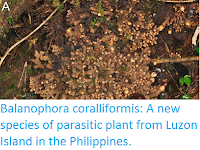Thismias (Thismiaceae) are a small group of Parasitic Plants found
throughout the tropics, with a few temperate species known from North
America, Japan, New Zealand and Australia. They parasitize the
Mycorrhizal Fungi with which all vascular plants have a relationship,
but where other plants exchange sugars produced by photosynthesis for
nutrients obtained from the soil by the Fungi, Thismias do not
photosynthesise, instead taking both nutrients and sugars from the Fungi
and giving nothing in return. In order to do this Thismias must target
Fungi in relationships with other Plants (since Fungi do not produce
sugars), preventing the Thismia from growing to any great size. Thismias
are related to Bat Flowers and Arrowroots; they were formerly
classified within the (also parasitic) Burmanniaceae, but it is now
recognised that while the two groups are fairly closely related, both
are more closely related to some non-parasitic plants than they are to
each-other.
In a paper published in the journal Phytotaxa on 5 September 2017, Pankaj Kumar, Stephen Gale and Ji-Hong Li of the Flora Conservation Department at Kadoorie Farm and Botanic Garden, Somsanith Bouamanivong of the Biotechnology and Ecology Institute of the Lao Ministry of Science and Technology, and Gunter Fischer, also of the Flora Conservation Department at Kadoorie Farm and Botanic Garden, describe a new species of Thismia from Laos.
The new species is named Thismia nigricoronata, where 'nigricoronata' means 'black-crowned'. The species reaches 5.5 cm in height, and is crowned by a dark structure formed from three fused perianth lobes. The species was found on a limestone slope at an altitude of 544 m, in Vang Vieng District of Vientiane Province in Laos. Only ten plants were found, though they were hard to detect and might therefore be more widespread, though Kumar et al. note that the area where the plants were found is a forest without protection, in immediate danger of clearance.
Thismia nigricoronata. (A) Plant in habitat. (B) Habit. (C) Close-up of the crown. (D) Whole plant showing the structure of the crown. (E) Whole plant showing the structure of the annulus. (F) Transverse section of the perianth tube. Kumar et al. (2017).
See also...
Follow Sciency Thoughts on Facebook.







